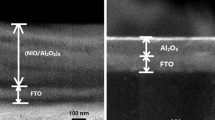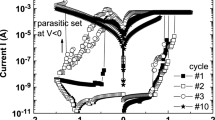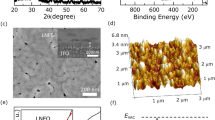Abstract
Three groups of ITO/BiFeO3 (BFO)/Al2O3 (AO)/Ag multilayer structures with AO film layer of different thickness were prepared by magnetron sputtering. All multilayer films exhibit the characteristics of bipolar resistive switching (RS). With the variation of the thickness of AO films, the switching behaviors of the memory devices change. Compared with other devices, the device with a 5-nm-thick AO layer shows more obvious bipolar resistive switching characteristics, and its maximum resistance ratio is about 30. There is a clear switching window in the negative bias region, and at a low reading voltage (~ − 0.5v), the device with the thinnest AO film exhibits a distinguishable high–low resistance state. It is interesting that, during the continuous cyclic voltage scanning, three types of I–V curves appear randomly and alternately in the sample with AO of 5 nm, which is rarely reported in the literature. In this paper, we propose the dual mechanism of the virtual cathode growth dominated by Ag ions and the formation and rupture of conductive filaments (CFs) contributed by Joule heating-assisted oxygen vacancies migration. This model successfully explains the reasons for the coexistence and conversion of three kinds of curves in the memory device with a 5-nm-thick AO film and also explains the different switching behaviors in the three groups of samples.






Similar content being viewed by others
References
H. Wang, X. Yan, Overview of resistive random access memory (RRAM): materials, filament mechanisms, performance optimization, and prospects. Physica Status Solidi (RRL)—Rapid Res. Lett. 13 (2019)
J.J. Yang, D.B. Strukov, D.R. Stewart, Memristive devices for computing. Nat. Nanotechnol. 8(1), 13–24 (2012)
R. Waser, M. Aono, Nanoionics-based resistive switching memories. Nat. Mater. 6(11), 833–840 (2007)
B. Sun, Y. Liu, W. Zhao et al., Hydrothermal preparation and white-light-controlled resistive switching behavior of BaWO4 nanospheres. Nano Micro Lett. 7(1), 80–85 (2015)
H. Akinaga, H. Shima, Resistive random access memory (ReRAM) based on metal oxides. Proc. IEEE 98(12), 2237–2251 (2010)
A. Wedig, M. Luebben, D.Y. Cho, et al., Nanoscale cation motion in TaOx, HfOx and TiOx memristive systems. Nat. Nanotechnol. (2016)
S. Dirkmann, J. Kaiser, C. Wenger et al., Filament growth and resistive switching in hafnium oxide memristive devices. ACS Appl. Mater. Interfaces 10, 14857–14868 (2018)
I. Valov, R. Waser, J.R. Jameson, et al., Electrochemical metallization memories-fundamentals. Nanotechnology 22, 254003 (2011)
J. Strobel, M. Hansen, S. Dirkmann et al., In depth nano spectroscopic analysis on homogeneously switching double barrier memristive devices. J. Appl. Phys. 121(24), 80–83 (2017)
J. Qi, M. Olmedo, J. Ren et al., Resistive switching in single epitaxial ZnO nanoislands. ACS Nano 6(2), 1051–1058 (2012)
Z. Wu, X. Zhao, Y. Yang, et al., Transformation of threshold volatile switching to quantum point contact originated nonvolatile switching in graphene interface controlled memory devices. Nanoscale Adv. 1 (2019).
D.S. Jeong, B.J. Choi, C.S. Hwang, Study of the negative resistance phenomenon in transition metal oxide films from a statistical mechanics point of view. J. Appl. Phys. 100(11), 526–534 (2006)
S.E. Ahn, M.J. Lee, Y. Park et al., Write current reduction in transition metal oxide based resistance-change memory. Adv. Mater. 20(5), 924–928 (2008)
K.H. Ting, et al., Ni/NiO/HfO2 core/multishell nanowire ReRAM devices with excellent resistive switching properties. Adv. Electron. Mater. 4(11), 1800256–1800256 (2018)
G.D. Zhou, B. Sun, X.F. Hu et al., Negative photoconductance effect: an extension function of the TiOx-based memristor. Advanced Science 8(13), 2003765 (2021)
G.D. Zhou, Z.J. Ren, B. Sun, et al., Capacitive effect: an original of the resistive switching memory. Nano Energy 68, 104386 (2019)
G.D. Zhou, S.K. Duan, P. Li, et al., Coexistence of negative differential resistance and resistive switching memory at room temperature in TiOx modulated by moisture. Adv. Electron. Mater. 1700567 (2018)
S.B. Lee, S.C. Chae, S.H. Chang et al., Scaling behaviors of reset voltages and currents in unipolar resistance switching. Appl. Phys. Lett. 93(21), 52–54 (2008)
L.J. Wei, Y. Yuan, J. Wang et al., Bipolar resistive switching with negative differential resistance effect in Cu/BaTiO3/Ag device. Phys. Chem. Chem. Phys. 19(19), 11864–11868 (2017)
L. He, Z.M. Liao, H.C. Wu et al., Memory and threshold resistance switching in Ni/NiO core–shell nanowires. Nano Lett. 11(11), 4601–4606 (2011)
S.L. Barbera, D. Vuillaume, F. Alibart, Filamentary switching: synaptic plasticity through device volatility. ACS Nano 9(1), 941–949 (2015)
S. Yu, Y. Wu, R. Jeyasingh et al., An electronic synapse device based on metal oxide resistive switching memory for neuromorphic computation. IEEE Trans. Electron Devices 58(8), 2729–2737 (2011)
H. Wang, X. Yan, Overview of Resistive Random Access Memory (RRAM): materials, filament mechanisms, performance optimization, and prospects. Physica Status Solidi (RRL)—Rapid Res. Lett. 13(9) (2019)
Z. Wang, S. Joshi, S.E. Savel’Ev, et al., Memristors with diffusive dynamics as synaptic emulators for neuromorphic computing. Nat. Mater. (2016)
G.I. Meijer, Who wins the nonvolatile memory race? Science 319(5870), 1625–1626 (2008)
S.B. Lee, S.C. Chae, S.H. Chang, et al., Predictability of reset switching voltages in unipolar resistance switching. Appl. Phys. Lett. 94(17), 173504 (2009)
I.K. Yoo, M.J. Lee, D.H. Seo, et al., Interpretation of set and reset switching in nickel oxide thin films. Appl. Phys. Lett. 104(22), 222902.1–222902.4 (2014)
P. Zheng, B. Sun, Y. Zhao et al., Tunneling of carrier at the interface barrier induced nonvolatile resistive switching memory behaviors. Mater. Today Commun. 16, 164–168 (2018)
S.R. Rasu, L.W. Matin, Y.H. Chu et al., Appl. Phys. Lett. 92, 818 (2008)
R. Moubah, B. Poornaprakash, S.H. Park et al., Adv. Funct. Mater. 22, 4814–4818 (2012)
K. Ahadi, S.M. Mahdavi, A. Nemati et al., J. Mater. Sci. 22, 815–820 (2011)
C.C. Zhou, K.X. Jin, B.C. Luo et al., Mater. Lett. 64, 1713–1716 (2010)
J. Shang, G. Liu, H. Yang et al., Thermally stable transparent resistive random access memory based on all-oxide heterostructures. Adv. Funct. Mater. 24(15), 2171–2179 (2014)
Y. Wang, Q.H. Jiang, H.C. He et al., Multiferroic BiFeO3 thin films prepared via a simple sol-gel method. Appl. Phys. Lett. 88(14), R123 (2006)
J.J. Yang, F. Miao, M.D. Pickett, et al., Erratum: the mechanism of electroforming of metal oxide memristive switches. Nanotechnology 20(21), 215201 (2009)
X. Qiu, R. Wang, Z. Zhang, et al., Ultra-low voltage resistive switching of HfO2 buffered (001) epitaxial NiO films deposited on metal seed layers. Appl. Phys. Lett. 111(14), 142103 (2017)
Acknowledgements
This work is supported by the National Science Foundation of China (Grant No. 51372209).
Author information
Authors and Affiliations
Corresponding author
Additional information
Publisher's Note
Springer Nature remains neutral with regard to jurisdictional claims in published maps and institutional affiliations.
Rights and permissions
About this article
Cite this article
Lu, Y., Tang, Y., Li, X. et al. Three typical types of alternating I–V curves in ITO/BiFeO3/Al2O3/Ag multilayer structure. Appl. Phys. A 128, 229 (2022). https://doi.org/10.1007/s00339-022-05308-3
Received:
Accepted:
Published:
DOI: https://doi.org/10.1007/s00339-022-05308-3




